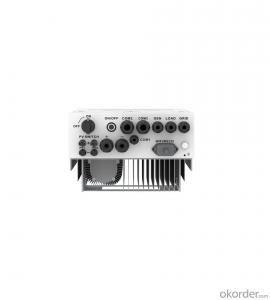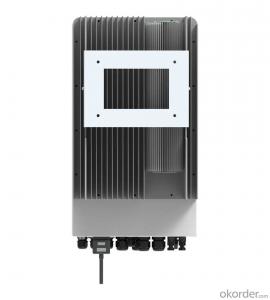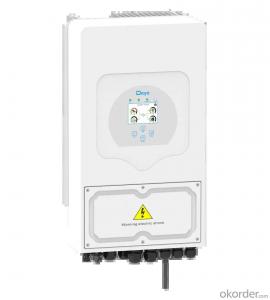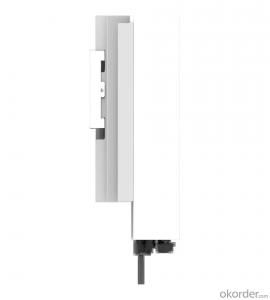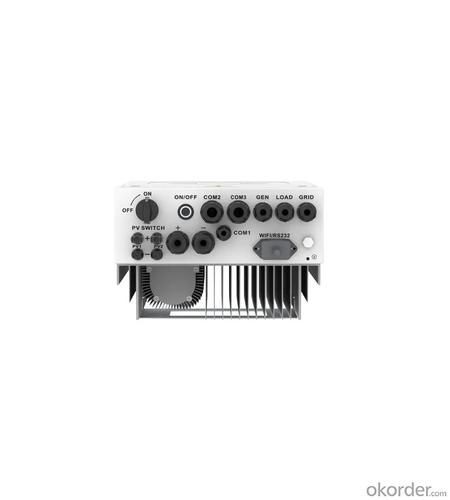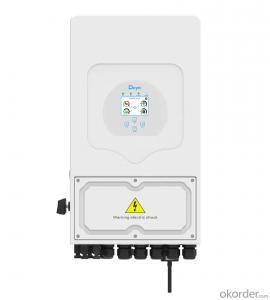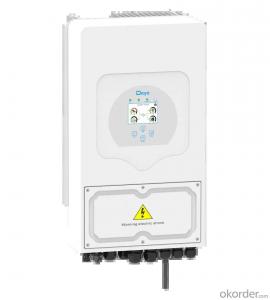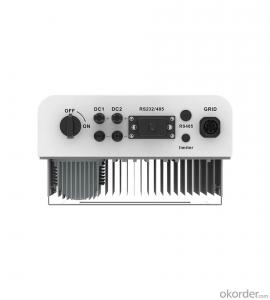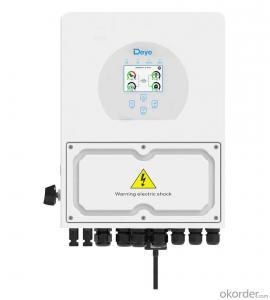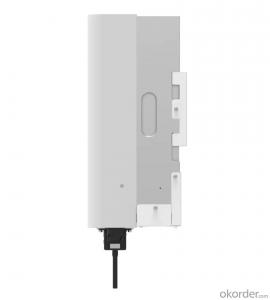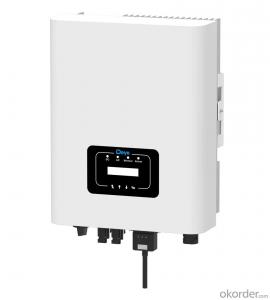120V Solar Inverter - Sun-6k-sg03lp1-eu | 6kW | Single Phase | 2 MPPT | Hybrid Inverter | Low Voltage Battery
- Loading Port:
- Ningbo
- Payment Terms:
- TT OR LC
- Min Order Qty:
- 100 pc
- Supply Capability:
- 5000 pc/month
OKorder Service Pledge
OKorder Financial Service
You Might Also Like
Specification
SUN 6K-SG,hybrid inverter, is suitable for residential and light commercial use, maximizing self-consumption rate of solar energy and increasing your energy impendence. During the day, the PV system generates electricity which will be provided to the loads initially. Then, the excess energy will charge the battery via SUN 6K-SG. Finally, the stored energy can be released when the loads require it. The battery can also be charged by the diesel generator to ensure uninterrupted supply in the event of grid blackout.
100% unbalanced output, each phase; Max. output up to 50% rated power
DC couple and AC couple to retrofit existing solar system
Max. 16pcs parallel for on-grid and off-grid operation; Support multiple batteries parallel
Max. charging/discharging current of 240A
48V low voltage battery, transformer isolation design
6 time periods for battery charging/discharging
| Model | SUN-6K -SG03LP1-EU |
| Battery Input Data | Battery Input Data |
| Battery Type | Lead-acid or Li-lon |
| Battery Voltage Range (V) | 40~60 |
| Max. Charging Current (A) | 135 |
| Max. Discharging Current (A) | 135 |
| External Temperature Sensor | Yes |
| Charging Curve | 3 Stages / Equalization |
| Charging Strategy for Li-Ion Battery | Self-adaption to BMS |
| PV String Input Data | PV String Input Data |
| Max. DC Input Power (W) | 7800 |
| Rated PV Input Voltage (V) | 370 (125~500) |
| Start-up Voltage (V) | 125 |
| MPPT Voltage Range (V) | 150-425 |
| Full Load DC Voltage Range (V) | 300-425 |
| PV Input Current (A) | 13+13 |
| Max. PV ISC (A) | 17+17 |
| Number of MPPT / Strings per MPPT | 2/1+1 |
| AC Output Data | |
| Rated AC Output and UPS Power (W) | 6000 |
| Max. AC Output Power (W) | 6600 |
| AC Output Rated Current (A) | 27.3 |
| Max. AC Current (A) | 30 |
| Max. Continuous AC Passthrough (A) | 40 |
| Peak Power (off grid) | 2 time of rated power, 10 S |
| Power Factor | 0.8 leading to 0.8 lagging |
| Output Frequency and Voltage | 50/60Hz; L/N/PE 220/230Vac (single phase) |
| Grid Type | Single Phase |
| DC injection current (mA) | THD<3% (Linear load<1.5%)< td=""> |
| Efficiency | Efficiency |
| Max. Efficiency | 97.60% |
| Euro Efficiency | 97.00% |
| MPPT Efficiency | 99.90% |
| Protection | |
| Integrated | PV Input Lightning Protection, Anti-islanding Protection, PV String Input Reverse Polarity Protection, Insulation Resistor Detection, Residual Current Monitoring Unit, Output Over Current Protection, Output Shorted Protection, Surge protection |
| Output Over Voltage Protection | DC Type II/AC Type III |
| Certifications and Standards | |
| Grid Regulation | CEI 0-21, VDE-AR-N 4105, NRS 097, IEC 62116, IEC 61727, G99, G98, VDE 0126-1-1, RD 1699, C10-11 |
| Safety EMC / Standard | IEC/EN 61000-6-1/2/3/4, IEC/EN 62109-1, IEC/EN 62109-2 |
| General Data | |
| Operating Temperature Range (℃) | -45~60℃, >45℃ derating |
| Cooling | Natural cooling |
| Noise (dB) | <30 dB |
| Communication with BMS | RS485; CAN |
| Weight (kg) | 20.5 |
| Size (mm) | 330W x 580H x232D IP65 |
| Protection Degree | IP65 |
| Installation Style | Wall-mounted |
| Warranty | 5 years |
- Q: Can a solar inverter be used in a net metering system?
- Yes, a solar inverter can be used in a net metering system. A solar inverter is an essential component of a net metering system as it converts the direct current (DC) produced by the solar panels into alternating current (AC) that can be used to power homes or businesses. It also allows for any excess electricity generated to be fed back into the grid, earning credits or reducing the electricity bill through the net metering arrangement.
- Q: How does a solar inverter handle grid voltage variations?
- A solar inverter is equipped with a voltage regulation mechanism that allows it to handle grid voltage variations. It continuously monitors the grid voltage and adjusts the output voltage of the inverter accordingly to ensure a stable and consistent supply of electricity. This regulation mechanism helps to protect the inverter and the connected solar panels from any potential damage that may occur due to fluctuations in the grid voltage.
- Q: What is the maximum number of AC outputs in a solar inverter?
- The maximum number of AC outputs in a solar inverter varies depending on the model and design of the inverter. Some solar inverters may have a single AC output, while others can have multiple AC outputs, ranging from two to four or even more.
- Q: How does MPPT improve the performance of a solar inverter?
- MPPT (Maximum Power Point Tracking) is a technique used in solar inverters to enhance their performance and maximize the energy output of the solar panels. Solar panels generate direct current (DC) electricity, which needs to be converted into alternating current (AC) to be used by household appliances or fed back to the grid. However, the amount of power generated by solar panels varies depending on factors like sunlight intensity, temperature, shading, and panel orientation. MPPT algorithms enable solar inverters to continuously track and adjust the operating point of the solar panels to extract the maximum power available. By continuously monitoring the voltage and current output of the solar panels, the MPPT controller determines the optimal operating voltage and current that will yield the highest power output. This optimization process is crucial because solar panels have a specific voltage and current combination at which their power output is maximized, known as the maximum power point (MPP). By operating the solar panels at their MPP, MPPT significantly improves the overall efficiency and performance of the solar inverter. With MPPT, solar inverters can adapt to changing environmental conditions and extract the maximum available power from the solar panels. This allows for increased energy production, reducing the reliance on grid electricity and maximizing the return on investment in solar installations. In summary, MPPT improves the performance of a solar inverter by optimizing the operating point of the solar panels to extract the maximum power available. This leads to increased energy production, improved efficiency, and better utilization of solar energy resources.
- Q: What is the maximum AC voltage that a solar inverter can provide?
- The maximum AC voltage that a solar inverter can provide typically depends on the specific model and its specifications. However, in general, most solar inverters are designed to produce a maximum AC voltage of around 240 volts in residential installations and up to 480 volts in commercial or utility-scale installations.
- Q: Can a solar inverter be connected to a backup battery system?
- Yes, a solar inverter can be connected to a backup battery system. This allows the solar energy generated during the day to be stored in the backup battery system and used during times when the sun is not shining or during power outages.
- Q: Can a solar inverter be used with solar-powered remote sensing systems?
- Yes, a solar inverter can be used with solar-powered remote sensing systems. A solar inverter is responsible for converting the direct current (DC) produced by solar panels into alternating current (AC) that can be used to power electrical devices. In the case of solar-powered remote sensing systems, the solar inverter plays a crucial role in converting the DC power generated by the solar panels into AC power to operate the sensing equipment. This ensures the efficient utilization of solar energy in powering remote sensing systems.
- Q: Can a solar inverter be used in a remote location without access to the grid?
- No, a solar inverter cannot be used in a remote location without access to the grid. Solar inverters convert DC power generated by solar panels into AC power, which is suitable for use in homes and businesses connected to the electrical grid. Without access to the grid, there is no way to utilize the output of a solar inverter.
- Q: Can a solar inverter be remotely monitored and controlled?
- Yes, a solar inverter can be remotely monitored and controlled. Many modern solar inverters are equipped with advanced monitoring and communication capabilities, allowing them to be connected to a network and accessed remotely. This enables users to monitor the performance of their solar system, track energy production, and make adjustments or troubleshoot issues from a remote location using a computer, smartphone, or other devices.
- Q: Can a solar inverter be used with a grid-interactive system?
- Yes, a solar inverter can be used with a grid-interactive system. A grid-interactive system allows for the solar inverter to convert the DC power generated by the solar panels into AC power that can be used to power the home or business. It also allows for excess power to be fed back into the grid, thus reducing energy costs and providing additional benefits such as net metering.
Send your message to us
120V Solar Inverter - Sun-6k-sg03lp1-eu | 6kW | Single Phase | 2 MPPT | Hybrid Inverter | Low Voltage Battery
- Loading Port:
- Ningbo
- Payment Terms:
- TT OR LC
- Min Order Qty:
- 100 pc
- Supply Capability:
- 5000 pc/month
OKorder Service Pledge
OKorder Financial Service
Similar products
Hot products
Hot Searches
Related keywords
